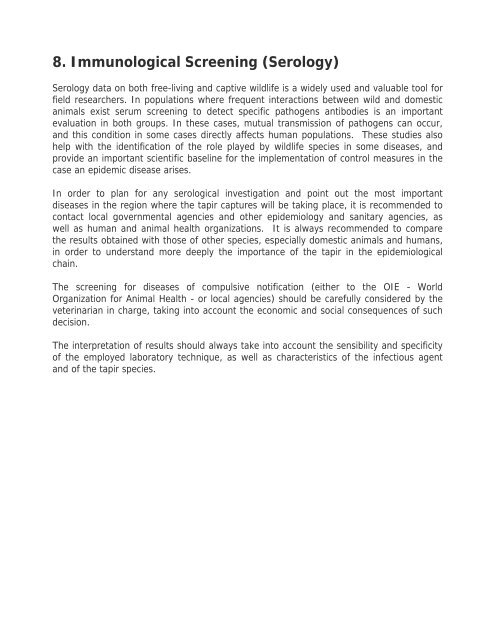TAPIR FIELD VETERINARY MANUAL - Tapir Specialist Group
TAPIR FIELD VETERINARY MANUAL - Tapir Specialist Group
TAPIR FIELD VETERINARY MANUAL - Tapir Specialist Group
Create successful ePaper yourself
Turn your PDF publications into a flip-book with our unique Google optimized e-Paper software.
8. Immunological Screening (Serology)<br />
Serology data on both free-living and captive wildlife is a widely used and valuable tool for<br />
field researchers. In populations where frequent interactions between wild and domestic<br />
animals exist serum screening to detect specific pathogens antibodies is an important<br />
evaluation in both groups. In these cases, mutual transmission of pathogens can occur,<br />
and this condition in some cases directly affects human populations. These studies also<br />
help with the identification of the role played by wildlife species in some diseases, and<br />
provide an important scientific baseline for the implementation of control measures in the<br />
case an epidemic disease arises.<br />
In order to plan for any serological investigation and point out the most important<br />
diseases in the region where the tapir captures will be taking place, it is recommended to<br />
contact local governmental agencies and other epidemiology and sanitary agencies, as<br />
well as human and animal health organizations. It is always recommended to compare<br />
the results obtained with those of other species, especially domestic animals and humans,<br />
in order to understand more deeply the importance of the tapir in the epidemiological<br />
chain.<br />
The screening for diseases of compulsive notification (either to the OIE - World<br />
Organization for Animal Health - or local agencies) should be carefully considered by the<br />
veterinarian in charge, taking into account the economic and social consequences of such<br />
decision.<br />
The interpretation of results should always take into account the sensibility and specificity<br />
of the employed laboratory technique, as well as characteristics of the infectious agent<br />
and of the tapir species.










